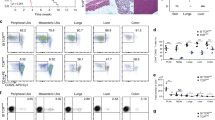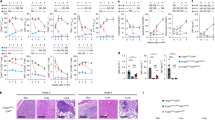Abstract
Maintenance of immune tolerance in the periphery can be envisioned as a balance between autoreactive lymphocytes and regulatory mechanisms that counteract them. The naturally occurring CD4+CD25+ regulatory T cells (TREGs) have a major role in modulating the activity of self-reactive cells. The identification of Forkhead box P3 transcription factor (FoxP3) as the critical determinant of TREG development and function has provided new opportunities and generated expanded interest in studying the balance between autoimmunity and regulatory mechanisms in human autoimmune diseases. The identification of both human and mouse diseases resulting from the lack of FoxP3 expression, and consequently the absence of TREGs, has rapidly expanded knowledge of TREG development and function during the past 5 years. Although it is still unclear how these regulatory cells function, they can inhibit the activation of potentially pathogenic T cells in vitro. Using in vitro functional assays and phenotypic analysis, TREGs isolated from patients with a variety of autoimmune diseases have been shown to exhibit reduced regulatory function as compared with those isolated from healthy controls. This Review will focus on the current state of knowledge on human TREGs and their association with specific autoimmune diseases.
Key Points
-
Regulatory T cells (TREGs) can be generated within the thymus or in peripheral tissues
-
Several autoimmune diseases have deficient TREG function during active disease
-
The proposed mechanisms of action of TREGs include influencing the migration of effectors to target organs or draining lymph nodes, prevention of priming by acting on antigen-presenting cells, induction of anergy in potential effectors, and prevention of the acquisition of effector function as effector T cells, killer effector cells or antigen-presenting cells
-
Studies investigating the function of TREGs in autoimmune diseases will provide further insight into the biology of these cells and might lead to the identification of new therapeutic targets
This is a preview of subscription content, access via your institution
Access options
Subscribe to this journal
Receive 12 print issues and online access
$209.00 per year
only $17.42 per issue
Buy this article
- Purchase on Springer Link
- Instant access to full article PDF
Prices may be subject to local taxes which are calculated during checkout

Similar content being viewed by others
References
Sakaguchi S (2004) Naturally arising CD4+ regulatory T cells for immunologic self-tolerance and negative control of immune responses. Annu Rev Immunol 22: 531–562
Shevach EM (2002) CD4+ CD25+ suppressor T cells: more questions than answers. Nat Rev Immunol 2: 389–400
Thornton AM and Shevach EM (1998) CD4+CD25+ immunoregulatory T cells suppress polyclonal T cell activation in vitro by inhibiting interleukin 2 production. J Exp Med 188: 287–296
Belkaid Y et al. (2002) CD4+CD25+ regulatory T cells control Leishmania major persistence and immunity. Nature 420: 502–507
Aluvihare VR et al. (2004) Regulatory T cells mediate maternal tolerance to the fetus. Nat Immunol 5: 266–271
Lu LF et al. (2006) Mast cells are essential intermediaries in regulatory T-cell tolerance. Nature 442: 997–1002
Shevach EM (2001) Certified professionals: CD4(+)CD25(+) suppressor T cells. J Exp Med 193: F41–46
Hori S et al. (2003) Control of regulatory T cell development by the transcription factor Foxp3. Science 299: 1057–1061
Yamagiwa S et al. (2001) A role for TGF-beta in the generation and expansion of CD4+CD25+ regulatory T cells from human peripheral blood. J Immunol 166: 7282–7289
Chen W et al. (2003) Conversion of peripheral CD4+CD25− naive T cells to CD4+CD25+ regulatory T cells by TGF-beta induction of transcription factor Foxp3. J Exp Med 198: 1875–1886
Bettelli E et al. (2006) Reciprocal developmental pathways for the generation of pathogenic effector TH17 and regulatory T cells. Nature 441: 235–238
Gavin MA et al. (2006) Single-cell analysis of normal and FOXP3-mutant human T cells: FOXP3 expression without regulatory T cell development. Proc Natl Acad Sci USA 103: 6659–6664
Walker MR et al. (2003) Induction of FoxP3 and acquisition of T regulatory activity by stimulated human CD4+CD25− T cells. J Clin Invest 112: 1437–1443
Valencia X et al. (2006) TNF down-modulates the function of human CD4+CD25hi T regulatory cells. Blood 108: 253–261
Davidson TS et al. (2007) Cutting Edge: IL-2 is essential for TGF-beta-mediated induction of Foxp3+ T regulatory cells. J Immunol 178: 4022–4026
Baecher-Allan C and Hafler DA (2004) Suppressor T cells in human diseases. J Exp Med 200: 273–276
Baecher-Allan C et al. (2001) CD4+CD25high regulatory cells in human peripheral blood. J Immunol 167: 1245–1253
Liu W et al. (2006) CD127 expression inversely correlates with FoxP3 and suppressive function of human CD4+ T reg cells. J Exp Med 203: 1701–1711
Seddiki N et al. (2006) Expression of interleukin (IL)-2 and IL-7 receptors discriminates between human regulatory and activated T cells. J Exp Med 203: 1693–1700
Valencia X et al. (2007) Deficient CD4+CD25high T regulatory cell function in patients with active systemic lupus erythematosus. J Immunol 178: 2579–2588
Harnaha J et al. (2006) Interleukin-7 is a survival factor for CD4+ CD25+ T-cells and is expressed by diabetes-suppressive dendritic cells. Diabetes 55: 158–170
Cao D et al. (2003) Isolation and functional characterization of regulatory CD25brightCD4+ T cells from the target organ of patients with rheumatoid arthritis. Eur J Immunol 33: 215–223
Prakken BJ et al. (2004) Epitope-specific immunotherapy induces immune deviation of proinflammatory T cells in rheumatoid arthritis. Proc Natl Acad Sci USA 101: 4228–4233
Feldmann M et al. (1996) Role of cytokines in rheumatoid arthritis. Annu Rev Immunol 14: 397–440
Hirota K et al. (2007) T cell self-reactivity forms a cytokine milieu for spontaneous development of IL-17+ Th cells that cause autoimmune arthritis. J Exp Med 204: 41–47
Pasare C and Medzhitov R (2003) Toll pathway-dependent blockade of CD4+CD25+ T cell-mediated suppression by dendritic cells. Science 299: 1033–1036
Ehrenstein MR et al. (2004) Compromised function of regulatory T cells in rheumatoid arthritis and reversal by anti-TNFalpha therapy. J Exp Med 200: 277–285
Nadkarni S et al. (2007) Anti-TNF-alpha therapy induces a distinct regulatory T cell population in patients with rheumatoid arthritis via TGF-beta. J Exp Med 204: 33–39
Weaver CT et al. (2007) IL-17 family cytokines and the expanding diversity of effector T cell lineages. Annu Rev Immunol 25: 821–852
Veldhoen M et al. (2006) TGFbeta in the context of an inflammatory cytokine milieu supports de novo differentiation of IL-17-producing T cells. Immunity 24: 179–189
Mills JA (1994) Systemic lupus erythematosus. N Engl J Med 330: 1871–1879
Cohen PL (1993) T- and B-cell abnormalities in systemic lupus. J Invest Dermatol 100: 69S–72S
Kotzin BL (1996) Systemic lupus erythematosus. Cell 85: 303–306
Lim HW et al. (2005) Cutting edge: direct suppression of B cells by CD4+ CD25+ regulatory T cells. J Immunol 175: 4180–4183
Lim HW et al. (2004) Regulatory T cells can migrate to follicles upon T cell activation and suppress GC-Th cells and GC-Th cell-driven B cell responses. J Clin Invest 114: 1640–1649
Crispin JC et al. (2003) Quantification of regulatory T cells in patients with systemic lupus erythematosus. J Autoimmun 21: 273–276
Liu MF et al. (2004) Decreased CD4+CD25+ T cells in peripheral blood of patients with systemic lupus erythematosus. Scand J Immunol 59: 198–202
Lee JH et al. (2006) Inverse correlation between CD4+ regulatory T-cell population and autoantibody levels in paediatric patients with systemic lupus erythematosus. Immunology 117: 280–286
Miyara M et al. (2005) Global natural regulatory T cell depletion in active systemic lupus erythematosus. J Immunol 175: 8392–8400
Fontenot JD et al. (2005) A function for interleukin 2 in Foxp3-expressing regulatory T cells. Nat Immunol 6: 1142–1151
Tsokos GC et al. (2003) T cell abnormalities in human and mouse lupus: intrinsic and extrinsic. Curr Opin Rheumatol 15: 542–547
Aringer M and Smolen JS (2004) Tumour necrosis factor and other proinflammatory cytokines in systemic lupus erythematosus: a rationale for therapeutic intervention. Lupus 13: 344–347
Banchereau J and Pascual V (2006) Type I interferon in systemic lupus erythematosus and other autoimmune diseases. Immunity 25: 383–392
Franz B et al. (2007) Low number of regulatory T cells in skin lesions of patients with cutaneous lupus erythematosus. Arthritis Rheum 56: 1910–1920
Fox RI and Maruyama T (1997) Pathogenesis and treatment of Sjogren's syndrome. Curr Opin Rheumatol 9: 393–399
Gottenberg JE et al. (2005) CD4 CD25high regulatory T cells are not impaired in patients with primary Sjogren's syndrome. J Autoimmun 24: 235–242
Abdulahad WH et al. (2007) Functional defect of circulating regulatory CD4+ T cells in patients with Wegener's granulomatosis in remission. Arthritis Rheum 56: 2080–2091
Miyara M et al. (2006) The immune paradox of sarcoidosis and regulatory T cells. J Exp Med 203: 359–370
Hafler DA (2004) Multiple sclerosis. J Clin Invest 113: 788–794
Viglietta V et al. (2004) Loss of functional suppression by CD4+CD25+ regulatory T cells in patients with multiple sclerosis. J Exp Med 199: 971–979
Haas J et al. (2005) Reduced suppressive effect of CD4+CD25high regulatory T cells on the T cell immune response against myelin oligodendrocyte glycoprotein in patients with multiple sclerosis. Eur J Immunol 35: 3343–3352
Korn T et al. (2007) Myelin-specific regulatory T cells accumulate in the CNS but fail to control autoimmune inflammation. Nat Med 13: 423–431
Balandina A et al. (2005) Functional defect of regulatory CD4(+)CD25+ T cells in the thymus of patients with autoimmune myasthenia gravis. Blood 105: 735–741
Fattorossi A et al. (2005) Circulating and thymic CD4 CD25 T regulatory cells in myasthenia gravis: effect of immunosuppressive treatment. Immunology 116: 134–141
Maillard MH et al. (2007) The Wiskott–Aldrich syndrome protein is required for the function of CD4(+)CD25(+)Foxp3(+) regulatory T cells. J Exp Med 204: 381–391
Chen Z et al. (2005) How defects in central tolerance impinge on a deficiency in regulatory T cells. Proc Natl Acad Sci USA 102: 14735–14740
Author information
Authors and Affiliations
Corresponding author
Ethics declarations
Competing interests
The authors declare no competing financial interests.
Rights and permissions
About this article
Cite this article
Valencia, X., Lipsky, P. CD4+CD25+FoxP3+ regulatory T cells in autoimmune diseases. Nat Rev Rheumatol 3, 619–626 (2007). https://doi.org/10.1038/ncprheum0624
Received:
Accepted:
Issue Date:
DOI: https://doi.org/10.1038/ncprheum0624
This article is cited by
-
Rosa roxburghii Tratt juice inhibits NF-κB and increases IL-2 to alleviates the Foxp3-mediated Tregs imbalance in the peripheral blood of arseniasis patients
Food Science and Biotechnology (2024)
-
The ubiquitin ligase Cul5 regulates CD4+ T cell fate choice and allergic inflammation
Nature Communications (2022)
-
Chronic urticaria and thyroid autoimmunity: a meta-analysis of case–control studies
Journal of Endocrinological Investigation (2022)
-
Molecular biochemical aspects of salt (sodium chloride) in inflammation and immune response with reference to hypertension and type 2 diabetes mellitus
Lipids in Health and Disease (2021)
-
Taurine promotes the production of CD4+CD25+FOXP3+ Treg cells through regulating IL-35/STAT1 pathway in a mouse allergic rhinitis model
Allergy, Asthma & Clinical Immunology (2021)



